Augmented Analytics Driven by AI: A Digital Transformation beyond Business Intelligence
Abstract
:1. Introduction
2. Background
2.1. Generations of BI
2.1.1. BI 1.0
2.1.2. BI 2.0
2.1.3. BI 3.0
2.2. Reasons for Expanding to AA (BI 3.0)
2.3. How AA Platforms Are Used in the Business Analytics Cycle
3. Related Work
3.1. Benefits of Utilizing Augmented BI Platforms
3.2. Healthcare Industry
3.3. Financial Industry
3.4. Logistics and Transportation Industry
3.5. Manufacturing Industry
4. Proposed Method
4.1. Business Understanding
4.2. Data Understanding
4.3. Data Preparation
5. Modelling and Evaluation
5.1. ML Models
5.2. Data Visualization
5.3. Deployment
6. Discussion
7. Conclusions and Future Work
Author Contributions
Funding
Acknowledgments
Conflicts of Interest
References
- Oesterreich, T.; Anton, E.; Xu, F. Augmenting the Future: An Exploratory Analysis of the Main Resources, Use Cases, and Implications of Augmented Analytics. In Proceedings of the European Conference on Information Systems, Virtual, 14–16 June 2021. [Google Scholar]
- Abas, Z.A.; Rahman, F.N.; Pramudya, G.; Wee, S.Y.; Kasmin, F.; Yusof, N.; Yunos, N.M.; Abidin, Z.Z. Analytics: A review of current trends, future application and challenges. Compusoft 2020, 9, 3560–3565. [Google Scholar]
- Ukhalkar, P.; Parakh, S.; Phursule, R.N.; Sanu, L. Augmented analytics and modern business intelligence adoption to maximize business value. J. Univ. Shanghai Sci. Technol. 2021, 23, 286–296. [Google Scholar] [CrossRef]
- How Augmented Analytics Will Transform Your Organization. In Gartner Trend Insight Report. 2019. Available online: https://www.gartner.com/en/doc/441420-how-augmented-analytics-will-transform-your-organization (accessed on 18 August 2022).
- Augmented Analytics, What It Is, Why It Matters, and Best Practices. Available online: https://www.qlik.com/us/augmented-analytics (accessed on 19 August 2022).
- Prat, N. Augmented analytics. Bus. Inf. Syst. Eng. 2019, 61, 375–380. [Google Scholar] [CrossRef]
- Minu, M.S.; Ahmad, Z. Augmented analytics: The future of business intelligence. Recent Trends Comput. Sci. Softw. Technol. 2020, 5, 7–13. [Google Scholar]
- Pribisalić, M.; Jugo, I.; Martinčić-Ipšić, S. Selecting a business intelligence solution that is fit for business requirements. In Proceedings of the Bled eConference, Humanizing Technology for a Sustainable Society, Bled, Slovenia, 16–19 June 2019. [Google Scholar]
- Kadijevich, D.; Stephens, M. Modern statistical literacy, data science, dashboards, and automated analytics and its applications. Teach. Math. 2020, 23, 71–80. [Google Scholar]
- Bulusu, L.; Abellera, R. Introduction-Three Generations of BI. In AI Meets BI: Artificial Intelligence and Business Intelligence, 1st ed.; Auerbach Publications: Boca Raton, FL, USA; London, UK; New York, NY, USA; CRC Press: Boca Raton, FL, USA, 2020; pp. 3–7. [Google Scholar]
- Bordeleau, F.; Mosconi, E.; Santa-Eulalia, L.A. Business Intelligence in Industry 4.0: State of The Art and Research Opportunities. In Proceedings of the Hawaii International Conference on System Sciences, Waikoloa Village, HI, USA, 3–6 January 2018. [Google Scholar]
- The Why of Things. Available online: https://decooda.com/ (accessed on 19 August 2022).
- IBM Infosphere Advanced Data Preparation. Available online: https://www.ibm.com/uk-en/products/infosphere-advanced-data-preparation (accessed on 19 August 2022).
- Tableau AI Brings the Future into Today’s Decisions. Available online: https://www.tableau.com/solutions/smart-analytics (accessed on 19 August 2022).
- The 4 Pillars of Mlops, Part 1: Production Model Deployment. Available online: https://www.datarobot.com/resources/mlops-model-deployment/ (accessed on 19 August 2022).
- Democratize, A.I. Available online: https://www.h2o.ai/ (accessed on 19 August 2022).
- Autonomous Forecast Analytics. Available online: https://www.anodot.com/autonomous-forecast/ (accessed on 19 August 2022).
- Augmented and Predictive Analytics Features. Available online: https://www.sap.com/mena/products/cloud-analytics/features/augmented-analytics.html (accessed on 19 August 2022).
- Richardson, J.; Schlegel, K.; Sallam, R.; Kronz, A.; Sun, J. Gartner Magic Quadrant for Analytics and Business Intelligence Platforms, in Gartner Research 2021. Available online: https://www.gartner.com/en/documents/3996944 (accessed on 18 August 2022).
- What Is Augmented Analytics. Available online: https://powerbi.microsoft.com/en-my/augmented-analytics/ (accessed on 18 August 2022).
- Augmented Analytics the Future of Data and Analytics. Available online: https://www.thoughtspot.com/solutions/is-augmented-analytics-future-data-analytics (accessed on 19 August 2022).
- Grigorescu, A.; Baiasu, D.; Chitescu, R.I. Business intelligence, the new managerial tool: Opportunities and limits. Ovidius Univ. Ann. Econ. Sci. Ser. 2020, 20, 651–657. [Google Scholar]
- Jain, T.; Agarwal, M.; Kumar, A.; Verma, V.K.; Yadav, A. Building machine learning application using oracle analytics cloud. In Data Engineering for Smart Systems; Lecture Notes in Networks and Systems; Springer: Singapore, 2022; Volume 238. [Google Scholar]
- Sakhnyuk, P.A.; Sakhnyuk, T.I.; Korshikova, M.V. The Use of Intelligent Technologies of Business Intelligence Platforms and Data Science and Machine Learning Platforms for Monitoring the Socio-Economic Indicators of The Administrative Districts of Moscow. IOP Conf. Ser. Mater. Sci. Eng. 2020, 873, 012015. [Google Scholar] [CrossRef]
- Shaari, H.; Durmić, N.; Ahmed, N. Modern ABI platforms for healthcare data processing. In Advanced Technologies, Systems, and Applications VI, IAT 2021; Lecture Notes in Networks and Systems; Springer: Cham, Switzerland, 2021; Volume 316, pp. 187–202. [Google Scholar]
- Ponea, M.G.; Ponea, I.A. How can the companies make their processes more efficient by transforming the way of using their data in today’s competitive environment. Ovidius Univ. Ann. Econ. Sci. Ser. 2020, 20, 1074–1078. [Google Scholar]
- Kaya, I.; Akbulut, D.H. Big Data Analytics in Financial Reporting and Accounting. In Proceedings of the Global Business Research Congress, Istanbul, Turkey, 24–25 May 2018; Academia Press: New York, NY, USA, 2018; Volume 7, pp. 256–259. [Google Scholar]
- Tran, K.T. Freight Spend Visualization and Analytics with BI Tools. Master’s Thesis, Metropolia University of Applied Sciences, Helsinki, Finland, 2021. [Google Scholar]
- Titu, A.M.; Stanciu, A. Acquiring Business Intelligence Through Data Science: A Practical Approach. In Proceedings of the International Conference on Electronics, Computers and Artificial Intelligence (ECAI), Bucharest, Romania, 25–27 June 2020. [Google Scholar]
- Salvadorinho, J.; Teixeira, L.; Santos, B.S. Storytelling with data in the context of industry 4.0: A power BI-based case study on the shop floor. In Proceedings of the International Conference on Human-Computer Interaction, Copenhagen, Denmark, 19–24 July 2020; Volume 12427, pp. 641–651. [Google Scholar]
- George, G.A.; Landryova, L. Interaction Between Human and AI Systems-When Automated Systems Move Towards Autonomous. In Proceedings of the International Carpathian Control Conference, Kraków-Wieliczka, Poland, 26–29 May 2019; pp. 1–6. [Google Scholar]
- Data Science Process Alliance. Available online: https://www.datascience-pm.com/crisp-dm-2/ (accessed on 19 August 2022).
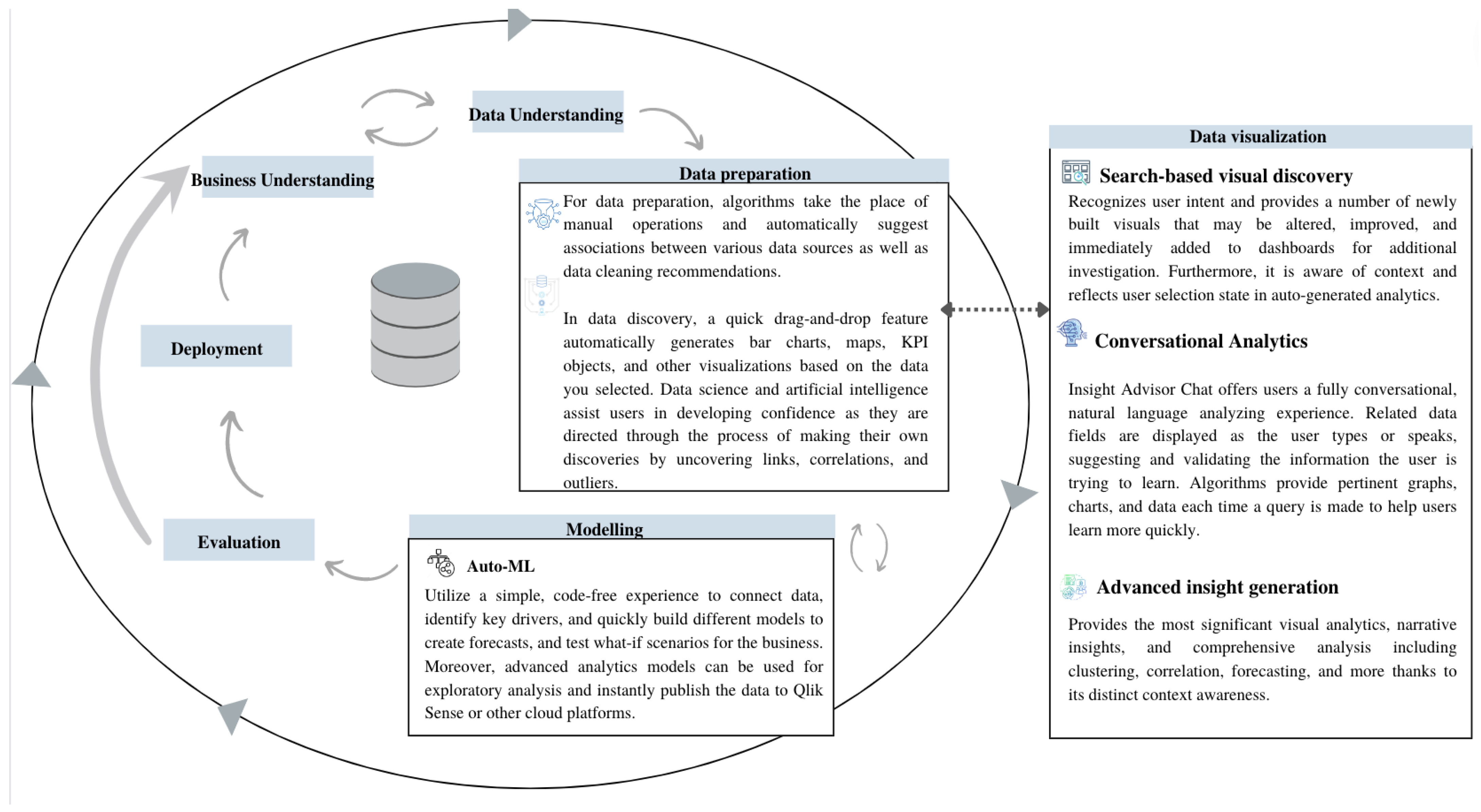
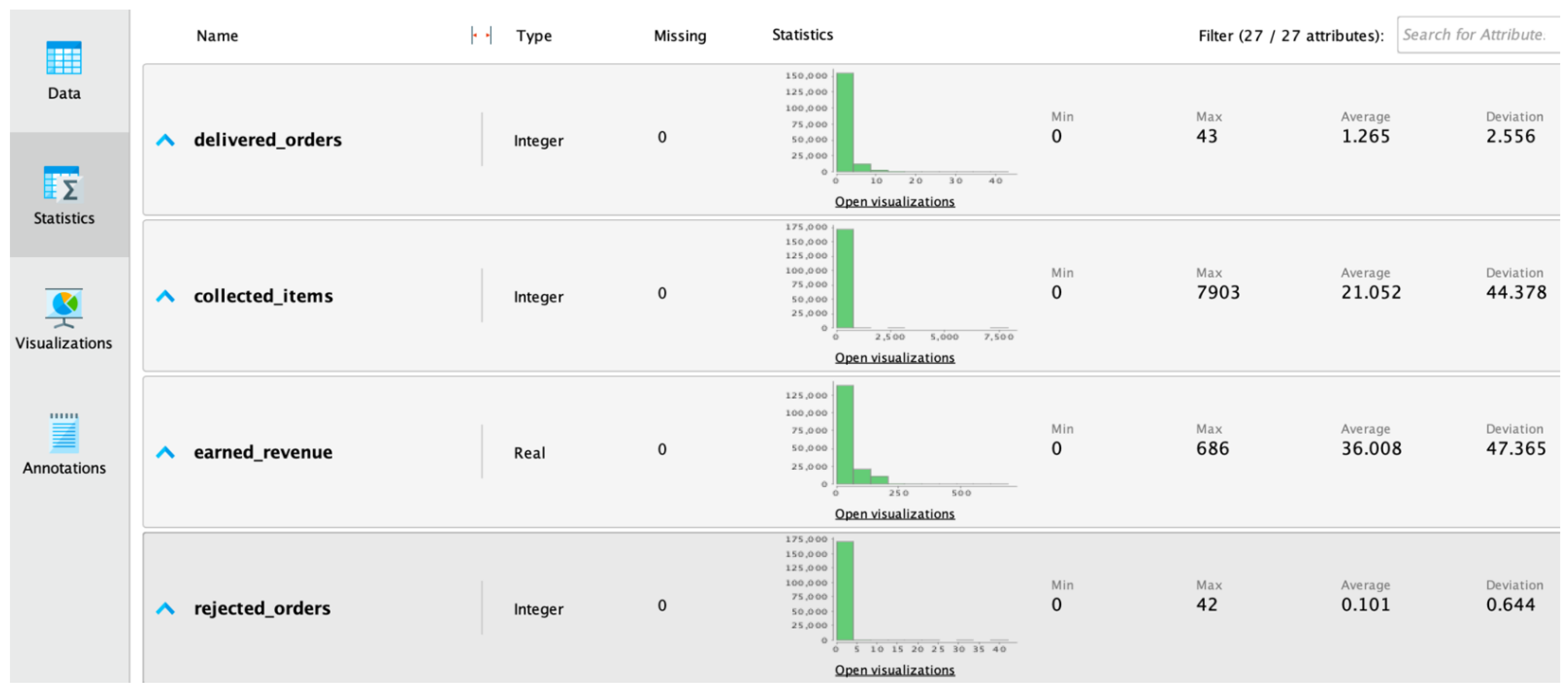



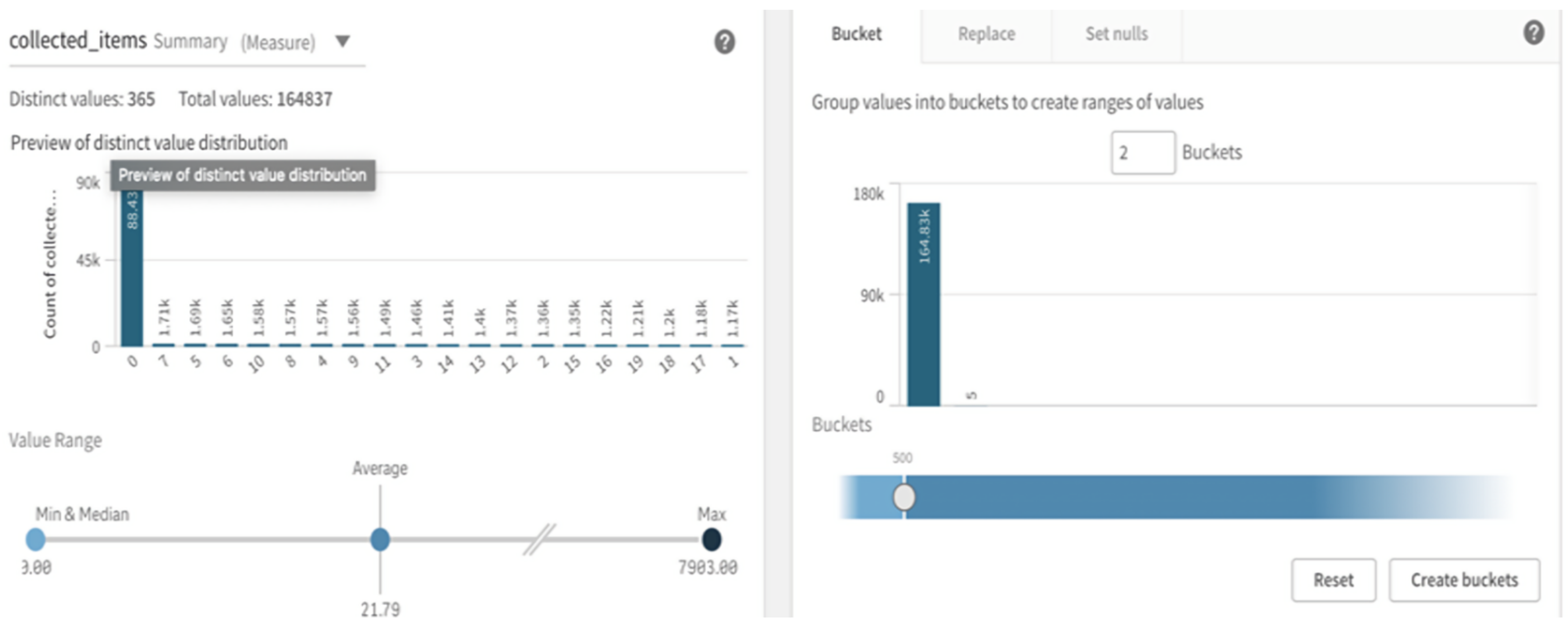



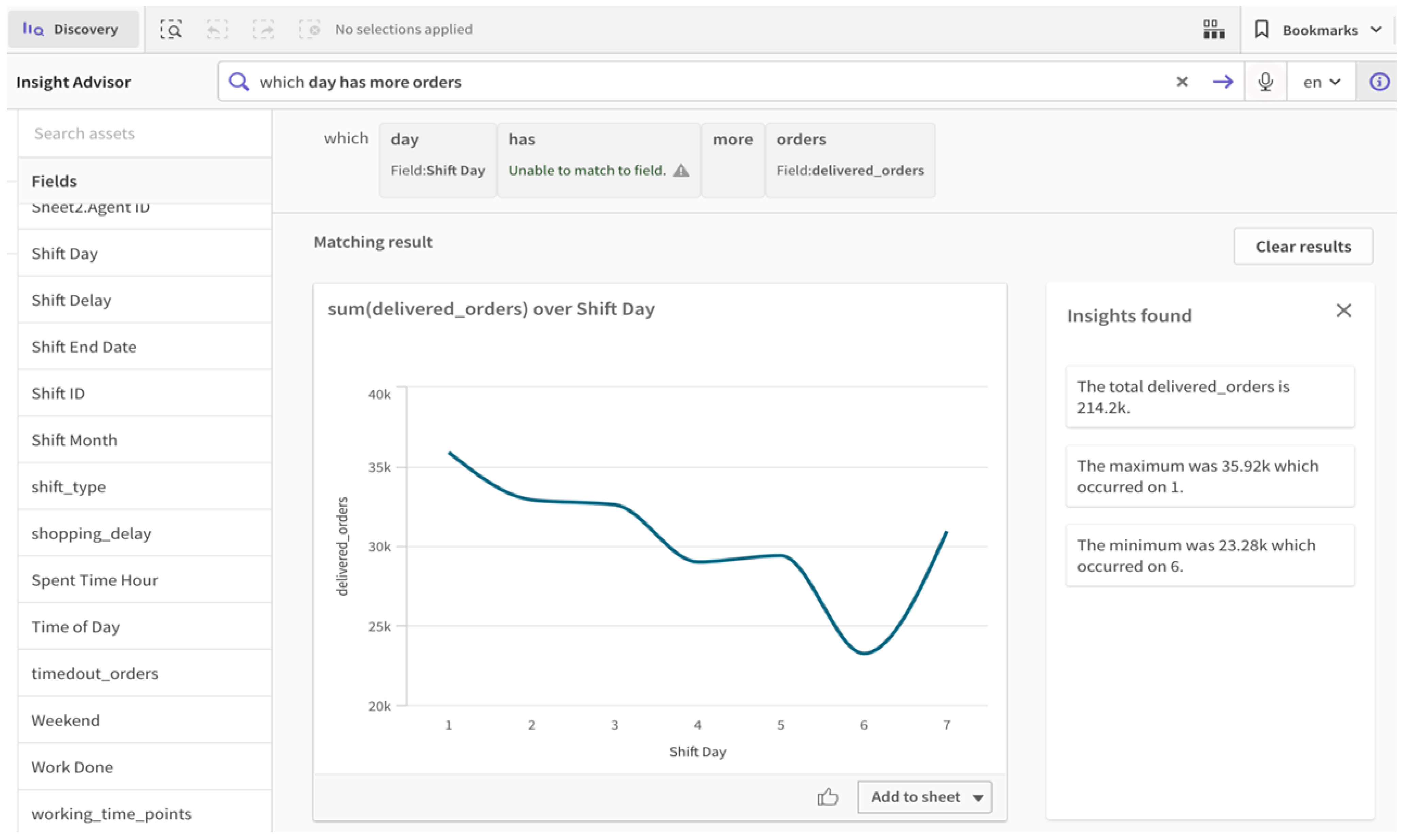

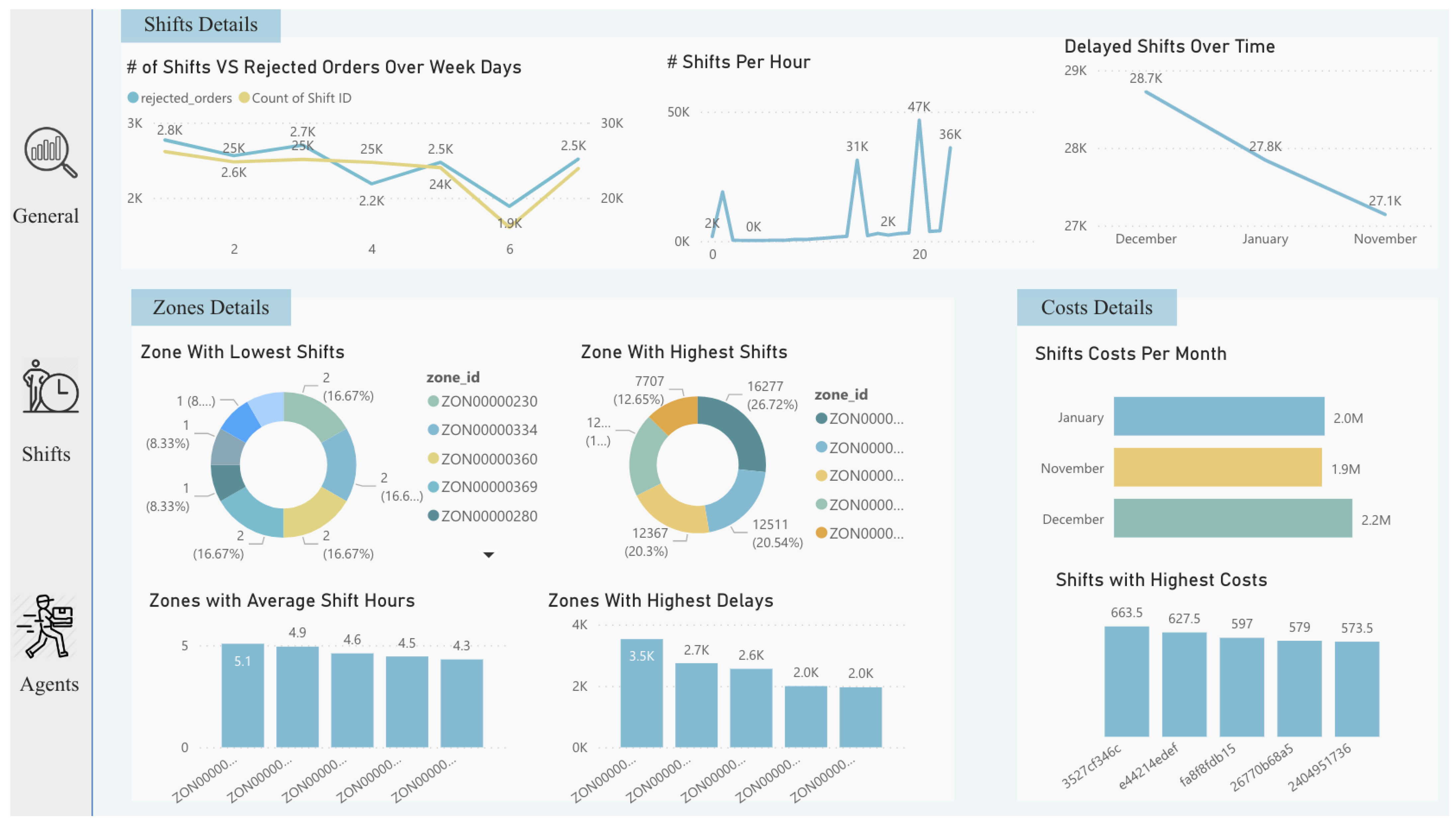

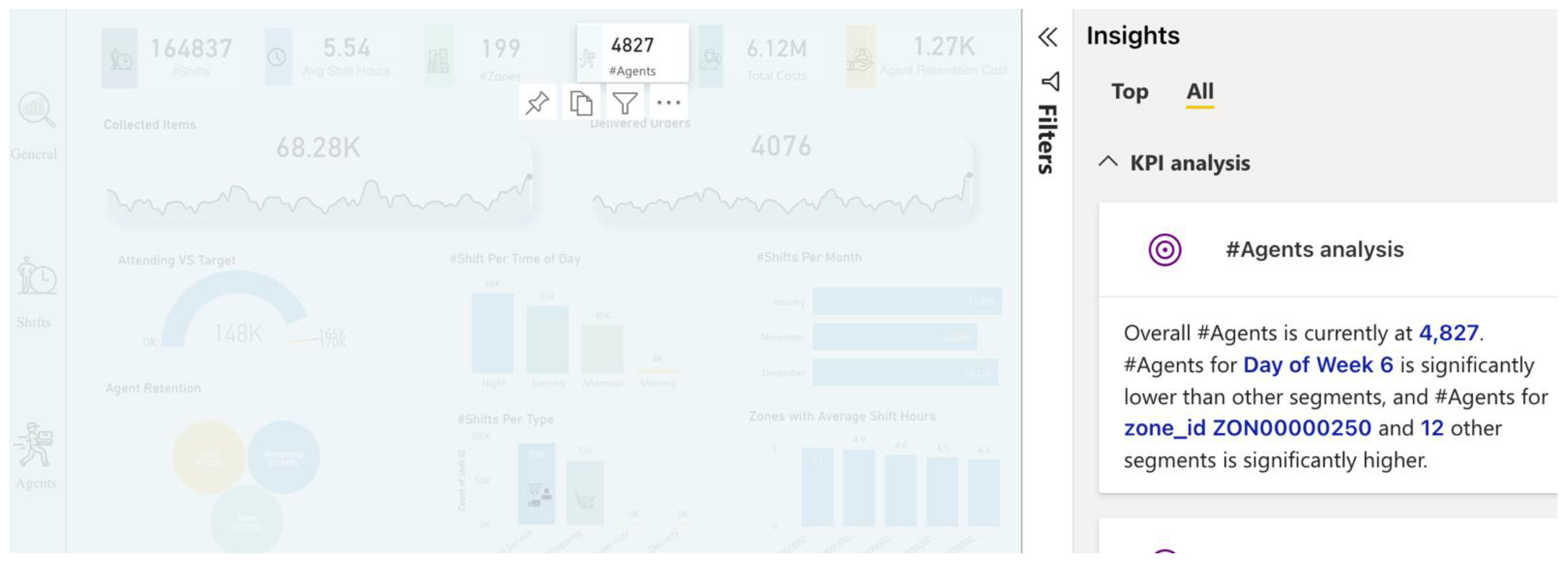
| BI | AA |
|---|---|
| OLAP | Search-based visual analysis and conversational analytics that is NL-driven (NLP) |
| Ad hoc queries | Interactive and informative analytical dashboards |
| Dashboards and scorecards | Data storytelling |
| Reporting by tracking KPIs and metrics | Predictive and prescriptive analytics |
| Descriptive analytics | Real-time advanced analytics |
| Operational and real-time BI | Scenario analysis |
| Manually preparing data and digging deeper into the data for more targeted information | Smart discovery and automated insights |
| Accelerated data preparation | |
| Big data analytics |
| Tool | Description |
|---|---|
| Qlik | Qlik’s Sense is a high-performance tool that allows users with different analytical levels to search and analyze any dataset. Qlik’s AA component, Insight Advisor, facilitates data exploration by automatically generating insights based on data analysis, which automates and speeds up the data preparation process. Its search-based visual analysis displays hidden insights as powerful visuals that can be modified and adjusted to create effective dashboards. Furthermore, NLP is used in conversational analytics, which allows users to evaluate data in a conversational manner [5]. |
| Power BI | Power BI allows analysts to perform data preparation, data discovery, and building of dashboards using similar design techniques. The platform works with Excel and Office 365 and consists of an active user community that builds the tool’s potential. Power BI’s analytical capabilities are enhanced by the availability of powerful AA capabilities and ML algorithms. Furthermore, features such as Quick Insights and Q&A visualizations allow users to easily examine and interpret data. Other elements, such as text analytics and visual analytics, enable customers to successfully employ the analytics capabilities in their data analysis [20]. |
| Tableau | Tableau fully integrates Einstein analytics to leverage AI technologies to examine and analyze data in order to make predictions and recommendations based on those findings. The presence of features such as Ask Data and Explain Data demonstrates that the industry is moving beyond traditional visualization-based solutions. In addition, Tableau uses smart analytics tools such as NLP and NLG to give customers a better data analysis experience [14]. |
| ThoughtSpot | ThoughtSpot is a BI and analytics company known for its highly scalable and relational analytics search engine, which allows business users to interact easily with data. It is considered one of the first BI suppliers to deliver AI-generated insights throughout the user experience, from a smart homepage to search, dashboards, and datasets. It has a user-friendly interface for providing automated insights and allows users to ask questions and execute queries [21]. |
| Model | Accuracy | Precision |
|---|---|---|
| DT | 65.42% | 63.11% |
| RF | 70.81% | 63.88% |
| NB | 63.08% | 63.93% |
| LR | 64.76% | 63.68% |
| Data Understanding and Reparation | Finding Patterns in Data and Visualizations | Modelling | |
|---|---|---|---|
| BI | Users perform manual data preparation, cataloguing, and ensure data quality, with limited automated transformation. | Users explore the relationships and patterns in data manually using interactive visualizations, create measures and metrics, and build the dashboard based on how the user interprets the results. | Manually tune models to find the best parameters. Choose a way to cross-validate by running through multiple training and evaluation strategies to obtain optimal results. Manually compare and select between the generated models. |
| AA | AA platform performs automatic data profiling, uses algorithms to recommend data enrichment, finds outliers and correlations, and transforms data via automated processes. AI is used to highlight important attributes useful for analysis. | AI-based capabilities are used to recommend visual types based on the characteristics, correlations, and relationships between variables. Users can utilize conversation analysis by asking questions using NLP. ML helps to generate automatic insights. Insights are narrated and summarized using NLG. Users can perform data storytelling to share insights. | Automatically choose suitable cross-validation techniques, evaluate variable contributions, and select features. AutoML generates and combines models to obtain optimal models and retunes them to obtain optimal results. Rank ML algorithms and model parameters to improve the productivity of modelling and limit the risk of biases towards model selection. AI enables users to perform scenario and “what-if “analysis for future predictions. |
Publisher’s Note: MDPI stays neutral with regard to jurisdictional claims in published maps and institutional affiliations. |
© 2022 by the authors. Licensee MDPI, Basel, Switzerland. This article is an open access article distributed under the terms and conditions of the Creative Commons Attribution (CC BY) license (https://creativecommons.org/licenses/by/4.0/).
Share and Cite
Alghamdi, N.A.; Al-Baity, H.H. Augmented Analytics Driven by AI: A Digital Transformation beyond Business Intelligence. Sensors 2022, 22, 8071. https://doi.org/10.3390/s22208071
Alghamdi NA, Al-Baity HH. Augmented Analytics Driven by AI: A Digital Transformation beyond Business Intelligence. Sensors. 2022; 22(20):8071. https://doi.org/10.3390/s22208071
Chicago/Turabian StyleAlghamdi, Noorah A., and Heyam H. Al-Baity. 2022. "Augmented Analytics Driven by AI: A Digital Transformation beyond Business Intelligence" Sensors 22, no. 20: 8071. https://doi.org/10.3390/s22208071
APA StyleAlghamdi, N. A., & Al-Baity, H. H. (2022). Augmented Analytics Driven by AI: A Digital Transformation beyond Business Intelligence. Sensors, 22(20), 8071. https://doi.org/10.3390/s22208071







